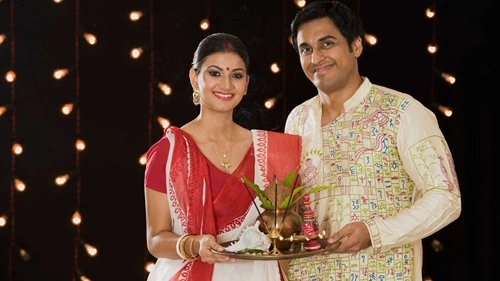To be honest, if you really want to see a true mix of culture and modernity, then without a single doubt, you should go visit the state of West Bengal. The language, the different religions, the lifestyles of people, and everything in between is just stunning in this state. And when you’re at it, you’ll have the first-hand experience of the culture just by looking at the way (traditionally) people dress in West Bengal. Today, specifically, we will talk about that, like the traditional dress of West Bengal, both for men and women.
Traditional Women’s Dress of West Bengal

1. The Bengali Saree
Well, it is true that a long time ago, women in Bengal used to just drape a single piece of cloth, you know, like without any blouse or petticoat or anything like that. But, then, later down the line, specifically in the British Era, the blouse (jama) and petticoat (shaya) became common, and that’s how the traditional saree dress evolved, which wasn’t way too long ago, actually. And just so you know, it is now known as Brahmika style.
And yes, even today, sarees are the top pick for Durga Puja, weddings, and all kinds of rituals. But talking about the different religions, well, that is where you’ll see the true diversity in the weaving styles of these sarees.
2. Popular Bengali Sarees
- Dhakai Jamdani: These are almost always made from fine muslin that’s almost transparent with floral designs woven using gold or silver threads. And if you look at it for the very first time, it’ll appear like a wearable art because of the detail and time it takes.
- Garad and Korial: These are super common in West Bengal too, where the color of these sarees is off white and pure white with a bright red color border. Plain and simple! Usually, you’ll see these being worn by married women, mainly in pujas or anything like that.
- Baluchari: Alright, so these are the pure silk sarees from Murshidabad. And there is some unique thing about the pallu part of these sarees because often, the pallus have scenes from epics like the Ramayana or Mahabharata.
- Tant: These are more casual and everyday types of sarees, often just made with light cotton. Why? Well, just because of the comfort aspect in the hot weather of West Bengal.
There are other saree options too, like Tussar silk from Malda, Kantha-stitched sarees with running hand embroidery, and Murshidabad silks with batik or block prints. These aren’t the most common options, but still, you’ll see some women wearing this type of saree in West Bengal specifically.
What Bengali Women Wear Today
Other than just the sarees, nowadays, since it is a modern time, a lot of women out there are preferring more clothing options like salwar kameez, kurtas, or skirts for daily use. That is pretty much the story in entirety of India, actually. While still in special events, pujas, and weddings, or some other celebrations, you’ll still see the majority of women in traditional dresses only.
Traditional Men’s Dress of West Bengal
1. The Panjabi
For those who are hearing about it for the very first time, well, a Panjabi is a knee-length kurta, usually cotton for everyday wear and silk for special occasions. And these are often decorated with those light Kantha stitch designs near the collar or buttons. These aren’t the regular or everyday wear options; rather, men prefer this type of attire on special occasions. We must say that it truly is the most common traditional dress of men down there in West Bengal.
2. The Dhoti
This has to be the most traditional attire option, not just in West Bengal but in all entire India. It is comfortable, breathable, and perfect for rituals. A lot of people wear it regularly, but mostly, today, men wear it for festivals, weddings, and Durga Puja.
How Men Dress Today
See, we talked about the common and traditional dress options for men in West Bengal, but nowadays, in this modern time, a lot of people are just going with the Western style of clothing as everyday attire. Though during the special events or festivals, no doubt, men prefer to go the traditional route and show their culture through the way they dress.